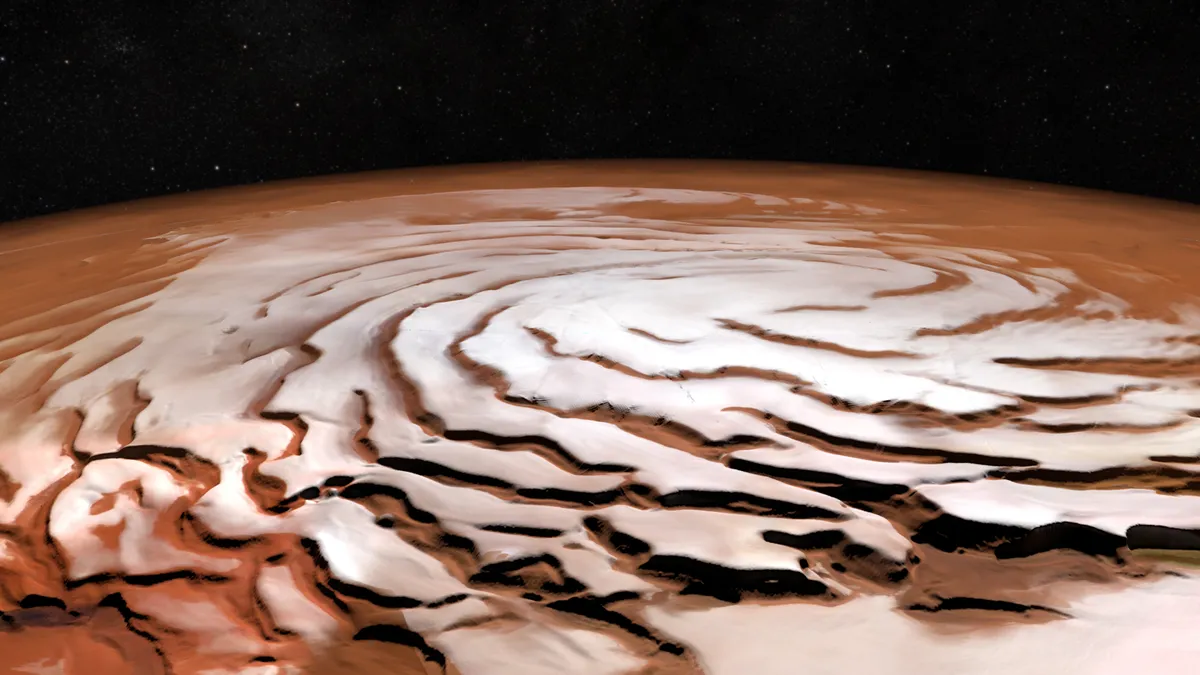The discovery of life on Mars has come to feel tantalisingly close over the past decade, with new findings by rovers and orbiters hinting at ancient biology hidden among the dried-up river beds and lakes where water once flowed on the Red Planet.
But scientists could have another avenue to explore in future missions: Martian ice.
More on Martian life

Ancient microbes or their remains could be found in Martian ice deposits, according to a study, and the results could have implications for future missions to the planet.
Ice on Mars?

Snow and ice is known to exist on Mars, and was verified by the 2008 NASA Mars Phoenix mission.
It was the first in-situ mission to excavate and capture photos of ice in Mars's equivalent of the Arctic Circle.
Now a team of scientists say their study shows fragments of molecules that make up proteins in E. coli bacteria, if present in Mars’s permafrost and ice caps, could survive for over 50 million years.
And that's despite the harsh, radiactive conditions on the Red Planet.
The team from NASA's Goddard Space Flight Center and Penn State University published their results in the science journal Astrobiology.
They say future missions to Mars should target locations on the planet with pure ice or ice-dominated permafrost, rather than focussing on rocks, clay and soil.

"Fifty million years is far greater than the expected age for some current surface ice deposits on Mars, which are often less than two million years old, meaning any organic life present within the ice would be preserved," says study co-author Christopher House, director of the Penn State Consortium for Planetary and Exoplanetary Science and Technology.
"That means if there are bacteria near the surface of Mars, future missions can find it."
The team, led by Alexander Pavlov, a space scientist at NASA Goddard, put E. coli bacteria in test tubes containing solutions of water ice.
Other E. coli samples were mixed with water and the same materials found in Mars sediment, such as silicate-based rocks and clay.

They froze the samples and put them in a gamma radiation chamber at Penn State’s Radiation Science and Engineering Center.
Cooling the samples to —50°C (–60°F), they blasted them with radiation equivalent to 20 million years of cosmic ray exposure on the Martian surface.
The samples were then sealed and taken to NASA Goddard for analysis, where the team modelled an additional 30 million years of radiation to total a 50-million-year timespan.
They say the results show that icy regions on Mars could be a key target for future missions looking for signs of life.

Martian life survives in ice
The study found that, in pure water ice, more than 10% of the amino acids — the molecular building blocks of proteins — from the E. coli sample survived the simulated 50 million years on Mars.
In contrast, samples containing Mars-like sediment degraded 10 times faster and did not survive.
The results follow a 2022 study by the same team, which found amino acids preserved in a mixture of 10% water ice and 90% Martian soil mixture were destroyed quicker than samples containing just sediment.
"Based on the 2022 study findings, it was thought that organic material in ice or water alone would be destroyed even more rapidly than the 10% water mixture," Pavlov says.
"So, it was surprising to find that the organic materials placed in water ice alone are destroyed at a much slower rate than the samples containing water and soil."
"While in solid ice, harmful particles created by radiation get frozen in place and may not be able to reach organic compounds.
"These results suggest that pure ice or ice-dominated regions are an ideal place to look for recent biological material on Mars."

Life in the Solar System
The results have clear implications for future missions to Mars searching for signs of life, but they could also be applied to the search across the rest of the Solar System, the team says.
They tested organic material in temperatures similar to those on Jupiter's moon Europa and Saturn's moon Enceladus.
These icy moons have liquid water beneath their frozen crusts, and are some of the most promising places to look for life in the Solar System.

That means the study's results could be good news for future missions at Jupiter's icy moons, like NASA's Europa Clipper and the European Space Agency's Juice mission.
"There is a lot of ice on Mars, but most of it is just below the surface," says House.
"Future missions need a large enough drill or a powerful scoop to access it, similar to the design and capabilities of Phoenix."

